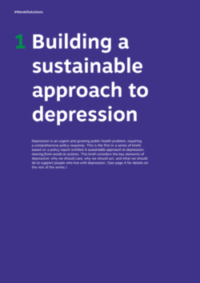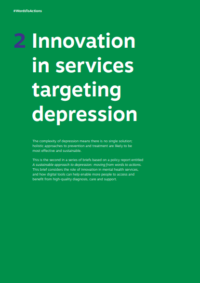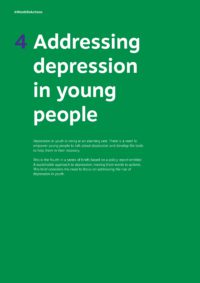
We need adequate and smarter investment in the prevention, management and care of depression across Europe.
Words to actions
More than 35 million people in Europe are estimated to live with depression, and that number is predicted to rise. As a cause of low productivity, depression imposes a considerable cost on society – and, more importantly, it takes a huge toll on the lives of the people it affects. Our societal response to depression remains far from adequate. The time has come to develop a sustainable approach to depression.
Nine organisations have joined forces to develop a report offering 10 policy recommendations based on best practice in mental health services. It was launched at the European Parliament in December 2018.

Building a sustainable approach to depression

Innovation in services targeting depression

A joint approach to suicide prevention

Addressing depression in young people

Integrated mental health services
Latest insights
Caring never stops. Neither should support for carers
24 Feb 2021
EUFAMI and The Health Policy Partnership It is a different world outside, where much of Europe has gone quiet under a third lockdown. Indoors, too, our homes may feel unfamiliar, reorganised into new online classrooms, office cubicles and hobby corners. The pandemic has been isolating for many people and provoked widespread anxiety. And for those […]
Why is depression important?
Given the growing impact of depression on individuals, their families and carers, communities and healthcare systems, merely recognising this rising challenge no longer suffices.
Policymakers need to act boldly and swiftly, ensuring adequate resources for the prevention, management and care of depression and seeking more effective ways of allocating them.


Depression in Europe: key facts
Prevalence
Depression can affect anyone, at any age.
More than 35 million people in Europe are estimated to live with depression.1
Cost
By 2030, depression will become the leading cause of disease burden in high-income countries.2
Depression costs healthcare systems up to €92 billion per year in Europe.3
It is the leading cause of low work-related productivity4 5
Impact
Depression in youth has a higher rate of recurrence and poorer outcomes compared to adult-onset depression.6
Around 15–20% of people with depression end their life by suicide.7
Suicide is the leading cause of death among 15–29-year-olds in Europe. 8
What can we do to tackle depression?
The nine organisations behind this campaign developed a report featuring 10 recommendations, based on findings from several international good practice examples.9
Together, these recommendations provide a concrete framework for a sustainable policy response to depression and can be used to guide adequate and smarter investment, for better outcomes in various areas.
Find out more about each recommendation in our interactive diagram below.
Ten key
factors in driving a
sustainable response
to depression
- Prevention across
all services - Joined-up
policies on suicide
prevention - Integrated
services - Digital tools
embedded in
practice - Language
that resonates - Engagement
and
empowerment - A whole-family
approach - Focus on
young people - A positive work
environment - Data to drive
change
Incorporate prevention into all services
Prevention is key to responding to the challenge of depression – and a preventive approach should be built into the design of all services. Prevention and early intervention are essential, particularly among younger people and those harder to reach through traditional medical services. Greater clarity about what early intervention means in practice is needed, however, to get more people into appropriate care.
Create joint government accountability for the prevention of suicide
Prevention of suicide is a key goal in depression care. Suicide can have multiple causes, therefore a cross-sectoral approach to suicide prevention is key. This needs to be reflected in joint government department responsibility and accountability.
Integrate services to make it easier for people to seek help
The legacy of discrimination around mental health means that people are generally averse to the term ‘mental illness’ and may be disinclined to seek care. Better integration of mental health services within other services may help reach more people. Using a different term, such as ‘wellbeing’, to denote mental health services may also help remove some of the associated stigma.
Embed digital solutions into practice
Digital health tools can help improve treatment choices for people and encourage them to take greater control of their care. However, these tools can meet resistance from some patients and also from health professionals who may not know how to integrate them into their treatment approach. Better training of health professionals and therapists is needed to facilitate blended care, which combines traditional and digital services.
Use language that resonates with people
Using language based on people’s experiences of care can be an important therapeutic tool. Terms such as ‘recovery’ are critical to convey a sense of hope and clarify treatment goals. Professionals working with people with depression should be encouraged to use a common language that is easy to understand by everybody and speaks to the experience of those being helped.
Engage people in their own and others’ recovery
Involving service users and carers in service and policy development will help ensure services work for the people who use them. Services should also draw on the strengths and capabilities of those who have overcome mental health challenges to empower others, for example through peer support.
Take a whole-family approach to care
Depression can affect the whole family – therefore, treatment should focus on the whole family, not just the person affected. Services that support carers are particularly important to protect their health and wellbeing.
Empower children and young people to talk about depression
Depression is increasing in young people at an alarming rate. We need to help young people use their own resources and skills to become more resilient and cope better with pressure. Digital tools can break through the isolation of young people battling depression and encourage them to seek help.
Create a positive work environment for people with depression
Adults spend most of their life in the workplace and depression is one of the leading causes of low productivity. More workplace education programmes are needed to promote a positive workplace culture, help management recognise the signs of depression and support people who are managing depression or returning to work after taking time off.
Evaluate practices to drive meaningful change
Lack of real-world data is a key gap in depression. We need greater investment in real-world data on the epidemiology of depression, service use and the impact of interventions and services if we are to better understand existing care gaps and implement sustainable change.
Get in touch
For any enquiries regarding the report or our wider project to tackle depression please contact us by completing the contact form or via the email below.
or email: contact@wordstoaction.eu
References
1.Global Burden of Disease Collaborative Network. 2017. Global Burden of Disease Study 2016 Results. Institute for Health Metrics and Evaluation. Available from: http://ghdx.healthdata.org/gbd-results-tool
2.Mathers CD, Loncar, D. 2006. Projections of Global Mortality and Burden of Disease from 2002 to 2030. PLoS Med 3(11):
3.Olesen J, Gustavsson A, Svensson M, et al. 2012. The economic cost of brain disorders in Europe. Eur J Neurol 19(1): 155-62
4. Evans-Lacko S, Koeser L, Knapp M, et al. 2016. Evaluating the economic impact of screening and treatment for depression in the workplace. European Neuropsychopharmacology 26(6): 1004-13
5.Ekman M, Granström O, Omerov S, et al. 2013. The societal cost of depression: evidence from 10,000 Swedish patients in psychiatric care. Journal of Affective Disorders 150(3): 790-97
6.Wilson S, Hicks BM, Foster KT, et al. 2015. Age of onset and course of major depressive disorder: associations with psychosocial functioning outcomes in adulthood. Psychol Med 45(3): 505-14
7.Miret M, Ayuso-Mateos JL, Sanchez-Moreno J, et al. 2013. Depressive disorders and suicide: epidemiology, risk factors, and burden. Neuroscience & Biobehavioral Reviews 37(10): 2372-74
8.World Health Organization Europe. 2017. Suicide prevention – new resource for media professionals. Available from: http://www.euro.who.int/en/health-topics/noncommunicable-diseases/mental-health/news/news/2017/09/suicide-prevention-new-resource-for-media-professionals
9.Beezhold J, Destrebecq F, Fresu M, et al. 2018. A sustainable approach to depression: moving from words to actions. Available from: https://www.healthpolicypartnership.com/wp-content/uploads/A_sustainable_approach_to_depression.pdf [Accessed 10/04/19]









